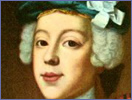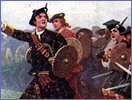
 |
 The Battle of Prestonpans was the first significant conflict in the second Jacobite Rising. The battle took place on September 21, 1745. The Jacobite army loyal to James Francis Edward Stuart and led by his son Charles Edward Stuart [Bonnie Prince Charlie] achieved a stunning Victory over the redcoat army loyal to the Hanoverian George II, led by Sir John Cope. It was initially known as the Battle of Gladsmuir but was fought at Prestonpans, East Lothian, Scotland on that town's borders with Tranent, Cockenzie and Port Seton. The victory was a huge morale boost for the Jacobites, and a heavily mythologized version of the story entered art and legend. The overall message then as today was one of Hope and Ambition in the breast of a young man and his followers.
The Battle of Prestonpans was the first significant conflict in the second Jacobite Rising. The battle took place on September 21, 1745. The Jacobite army loyal to James Francis Edward Stuart and led by his son Charles Edward Stuart [Bonnie Prince Charlie] achieved a stunning Victory over the redcoat army loyal to the Hanoverian George II, led by Sir John Cope. It was initially known as the Battle of Gladsmuir but was fought at Prestonpans, East Lothian, Scotland on that town's borders with Tranent, Cockenzie and Port Seton. The victory was a huge morale boost for the Jacobites, and a heavily mythologized version of the story entered art and legend. The overall message then as today was one of Hope and Ambition in the breast of a young man and his followers.
On 20 September Cope's forces encountered Charles's advance guard. Cope decided to stand his ground and engage the Jacobite army. He drew up his army facing south with a marshy ditch to their front, and the park walls around Preston House protecting their right flank. A Highlander supporter, Robert Anderson was a local farmer's son who knew the area well and convinced Charles's Lieutenant General, Lord George Murray of an excellent narrow route through the marshlands. Commencing at 4 a.m. he moved the entire Jacobite force walking three abreast along that route, known as the Riggonhead Defile, in total silence arriving to the east of Cope's army at Seton West Mains. Although Cope kept fires burning and posted pickets during the night as the Highlanders were making their move they were not spotted by the pickets until around 5 a.m.
 At 6 .m. as dawn boke, on 21 September 1745, Cope's foot soldiers and dragoons beheld the spectacle of some 2,000 Highlanders charging through the early mist making "wild war cries and with the bloodcurdling skirl of the pipes...."
At 6 .m. as dawn boke, on 21 September 1745, Cope's foot soldiers and dragoons beheld the spectacle of some 2,000 Highlanders charging through the early mist making "wild war cries and with the bloodcurdling skirl of the pipes...."
Cope's inexperienced army had just wheeled round from facing south to facing east in great haste but could only fire their cannons and muskets just once before the Highlanders were upon them. Then they fled despite Cope and his officers attempting to force them at pistol point to make a stand. Cope's army facing east to confront the Jacobites now had the ditch to their south and the walls of Preston House to the west behind them blocking their panicked retreat.
Colonel Gardiner, a senior Hanoverian commander who stayed at Bankton House close by the scene of battle, was mortally wounded in a final heroic skirmish that included by his side Sir Thomas Hay of Park who survived. Colonel Gardiner's fatal wounds were inflicted beneath a white thorntree of which a portion was sent in 1933 to the Edinburgh's Naval and Military Museum. [Another section is today held by the Battle Heritage Trust in Prestonpans.] Gardiner was taken to The Manse at Tranent where he died in the arms of a visiting Minister's daughter, Beatrix, before noon that day. The Colonel became the unchallenged hero of the day and an obelisk to his memory was raised in the mid 19th century.
The "battle engagement " was all over in less than fifteen minutes with hundreds of government troops killed or wounded and 1500 taken prisoner as the redcoats fled the field. The Hanoverian baggage train at Cockenzie was captured with only a single shot fired and it contained £5000, many muskets and ammunition. The Highlanders suffered less than 100 troops killed or wounded. The wounded and prisoners were given the best care possible at Prince Charles' insistence. A cairn to their memory was erected in 1953 close by the battle site and a coal bing using the remains of the area's coal shale shaped as a pyramid now provides a vantage point for today's visitors to the site to gain the fullest appreciation of the battle as it unfolded through interpretation boards. The Battle Trust has placed three additional interpretation boards on the battle scenes in 2010 after its detailed archaeological study identified the most likely location of the initial charge and clashes.
The Battle of Prestonpans 1745 Heritage Trust was established in 2006 to ensure more proper 'conservation, interpretation and presentation' of the battle and the Trust created plans for a Living History Centre in the community.The battlefield itself was immediately listed in the Scottish Government's national inventory of significant battle sites when that was established in 2009. The Trust appointed Martin Margulies, author of 'The Battle of Prestonpans 1745' as its official historian in 2007. In 2008 he became Colonel-in-Chief of the Alan Breck Regiment of Prestonpans Volunteers, which regiment has responsibility for annual re-enactments each September. In 2009/ 2010 Dr Andrew Crummy led a team of 200 + embroiderers across Scotland in the creation of the 104 metre Prestonpans Tapestry telling the story of the Prince's campaign in 1745 leading to Victory in Prestonpans.
 |
||
|